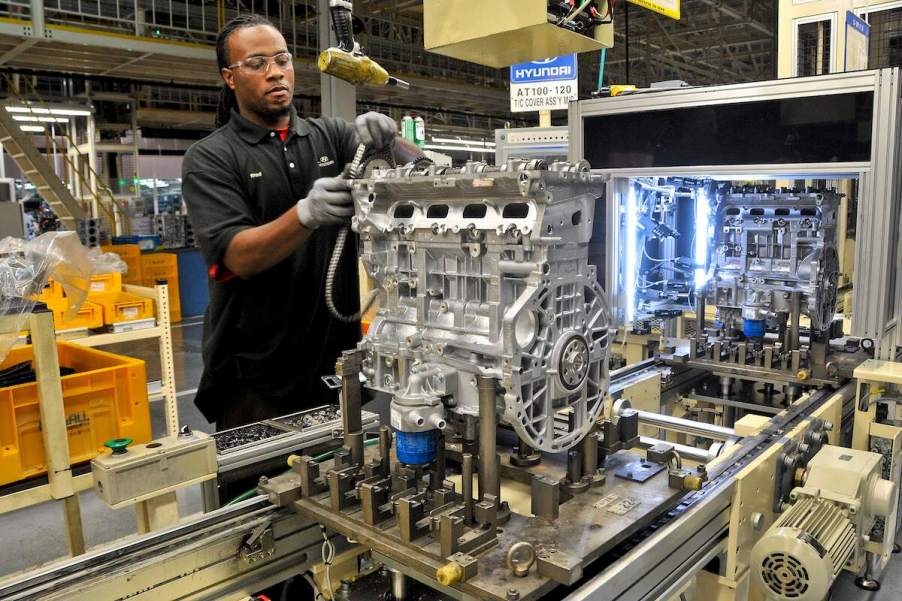
The 3 Drive Belts Found in New and Used Cars and What They Do
Oil changes, coolant flushes, and tire rotations are essential vehicle maintenance steps. They keep a car running longer, but changing the engine belts is another low-cost way to prevent breakdowns. So, let’s examine the three types of drive belts in new and used cars, including what they do, when to replace them, and their estimated replacement costs.
What are vehicle drive belts?
Drive belts are crucial in keeping your car on the road. An automotive drive belt is a loop made of a resilient rubber compound containing fibrous strands to prevent excessive stretching and endure years of use under the hood of your vehicle. However, as it applies to cars, “drive belt” is a generic term for the three types of belts found in most vehicles in some combination.
Your car could have one, two, or all three of the following drive belts:
- Serpentine belt
- V-belt
- Timing belt
What is a serpentine belt, and what does it do?

Serpentine belts transfer power from the car’s engine to other systems under the hood. The serpentine belt accomplishes this task by wrapping around the front of the car’s crankshaft pulley. Then it earns its name by snaking around pulleys attached to the alternator, air conditioner, water pump, and power steering pump through a series of idler and tensioner pulleys.
Serpentine belts often last over 100,000 miles, but contact with engine oil or coolant will shorten their lifespan. So experts recommend changing them every 50,000 miles.
Frequent visual inspections work best to assess the health of your car’s serpentine belt. If you see any cracking, fraying, or glazing (hard, shiny areas), change the belt immediately. Audible indications of a failing serpentine belt include squeaking, chirping, or squealing from under the hood.
J.D. Power estimates the average cost of replacing a serpentine belt is $109 to $134. Most shops should charge for about an hour of labor, and the average price of the belt is between $52 and $62. Replacing a serpentine belt yourself is relatively simple and requires only basic tools. However, take photos of the belt’s path before removing it, and check the pulley bearings before putting on the new one.
What is a V-belt, and how is it different from a serpentine belt?
Before serpentine belts, cars had V-belts. The function of v-belts in an internal combustion engine is much the same as serpentine belts. When you open the hood of a car equipped with V-belts, you’ll notice two differences:
- V-belts are wedge-shaped and are narrower and shorter than serpentine belts, which are longer, broader, and thicker. Also, serpentine belts have a smooth surface, whereas V-belts have ridges.
- An engine often has multiple V-belts from the crankshaft pulley, one for each component it powers.
An advantage of a V-belt system is that only that component stops working if one fails. However, multiple belts become a disadvantage when replacing them because V-belts cost more than serpentine belts and take additional shop hours to change individually.
What is a timing belt, and how is it different from serpentine and V-belts?
The first difference you’ll notice is upon opening your hood. You’ll see the serpentine or V-belts, but you won’t see the timing belt. A vehicle’s timing belt also connects to the engine crankshaft but is hidden behind a timing belt cover. Its job is to keep the crankshaft and its components rotating in precise relation to the camshaft(s) and associated valvetrain components.
A visual inspection of a timing belt requires nearly the same amount of work as replacing it. Warning signs of a bad timing belt include rough idle, ticking or slapping noises from the front of the engine, and complete engine failure.
Otherwise, you should change your timing belt according to the manufacturer’s schedule. Autozone says timing belts don’t cost much, but the labor to replace them ranges from several hundred dollars to $1,000 or more. Furthermore, a failed timing belt could lead to a complete engine overhaul or replacement costing several thousand dollars.
Keeping your car on the road requires routine maintenance. As with most auto parts, prevention is always less expensive and inconvenient than repairs after failure regarding drive belts.



